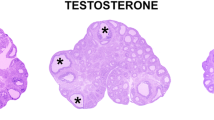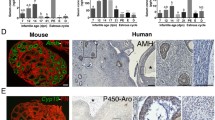Abstract
Ovaries of immature rats are endowed with only a small number of EGF binding sites (59.2 × 10−15 mol/mg protein). During development from day 20 to 28, the binding capacity increases 2.5 times, while the growth of the ovaries remains small. Treatment with FSH on day 20 advances the EGF binding capacity with a 4-fold increase in the number of binding sites within the first two days. HCG has no or only a slight effect on the EGF binding capacity. The EGF receptor formation after FSH treatment takes place before the ovaries begin to grow rapidly. Accelerated ovarian growth is associated with a decrease of EGF binding capacity reaching values below those of the control animals during the subsequent days. The dissociation constants (KD) of the FSH stimulated receptors and of receptors present during development are found in the order of 2.7 and 8.7 × 10−9 M. The physiological function of the EGF receptor for ovarian cell proliferation and follicular growth is discussed.
Similar content being viewed by others
References
Pedersen T. Follicle growth in the immature mouse ovary. Acta Endocrinol. (Kbh.) 62: 117, 1969.
Peters H., Byskov A.G., Himelstein-Braw R., Faber M. Follicular growth: the basic event in the mouse and human ovary. J. Reprod. Fertil. 45: 559, 1975.
Eshkol A., Lunenfeld B. Gonadotropic regulation of ovarian development in mice during infancy. In: Saxena B.B., Beling C.G., Gandy H.M. (Eds.), Gonadotropins. John Wiley & Sons, New York, 1972, p. 335.
Goldenberg R.L., Reiter F.O., Ross G.T. Follicle response to exogenous gonadotropins: an estrogen-mediated phenomen. Fertil. Steril. 24: 121, 1973.
Richards J.S., Midgley A.R. Jr. Protein hormone action: a key to understanding ovarian follicular and luteal cell development. Biol. Reprod. 14: 82, 1976.
Makris A., Klagsbrun M.; Yasumizu T., Ryan K.J. An endogenous ovarian growth factor which stimulates BALB/3T3 and granulosa cell proliferation. Biol. Reprod. 29: 1135, 1983.
Vlodavsky I., Brown K.D., Gospodarowicz D. A comparison of the binding of epidermal growth factor to cultured granulosa and luteal cells. J. Biol. Chem. 253: 3744, 1978.
Gospodarowicz D., Ill C.R., Birdwell C.R. Effects of fibroblast and epidermal growth factor on ovarian cell proliferation in vitro. I. Characterization of the response of granulosa cells to FGF and EGF. Endocrinology 100: 1108, 1977.
Gospodarowicz D., Bialecki H. Fibroblast and epidermal growth factors are mitogenic agents for cultured granulosa cells of rodent, porcine and human origin. Endocrinology 104: 757, 1979.
Bauknecht T., Rau B., Meerpohl H.G., Pfleiderer A. The prognostic value of the presence of EGF receptors in the ovarian carcinoma. Tumor Diagnostic Therapeutics 5: 62, 1984.
Carpenter G., Cohen S. 125I-labeled human epidermal growth factor. Binding, internalization and degradation in human fibroblasts. J. Cell Biol. 77: 159, 1976.
Scatchard G. The attraction of protein for small molecules and ions. Ann N.Y. Acad. Sci. 51: 660, 1949.
Jones P.B.C., Welsh T.H., Hsueh A.J.W. Regulation of ovarian progestin production by epidermal growth factor in cultured rat granulosa cells. J. Biol. Chem. 257: 11268, 1982.
Cohen S. The stimulation of epidermal proliferation by a specific protein. Dev. Biol. 72: 394, 1965.
Gospodarowicz D., Ill C.R., Birdwell C.R. Effects of fibroblast and epidermal growth factors on ovarian cell proliferation in vitro. II Proliferative response of luteal cells to FGF but not EGF. Endocrinology 100: 1121, 1977.
Lintern-Moore S., Moore G.P.M., Panaretto B.A., Robertson D. Follicular development in neonatal mouse ovary: effect of epidermal growth factor. Acta Endocrinol. (Kbh.) 96: 123, 1981.
Hsueh A.J.W., Welsh. T.H., Jones P.B.C. Inhibition of ovarian and testicular steroidogenesis by epidermal growth factor. Endocrinology 108: 2002, 1981.
Cohen S., Savage C.R. Jr. Part. II. Recent studies on the chemistry and biology of epidermal growth factor. Recent Prog. Horm. Res. 30: 551, 1974.
Carpenter G., Cohen S. Epidermal growth factor. Annu. Rev. Biochem. 48: 193, 1979.
Author information
Authors and Affiliations
Rights and permissions
About this article
Cite this article
Siebers, J.W., Bauknecht, T., Schopfer, A. et al. The influence of gonadotropic hormones on the EGF receptor regulation in the rat ovary. J Endocrinol Invest 8, 455–458 (1985). https://doi.org/10.1007/BF03348537
Received:
Accepted:
Published:
Issue Date:
DOI: https://doi.org/10.1007/BF03348537




